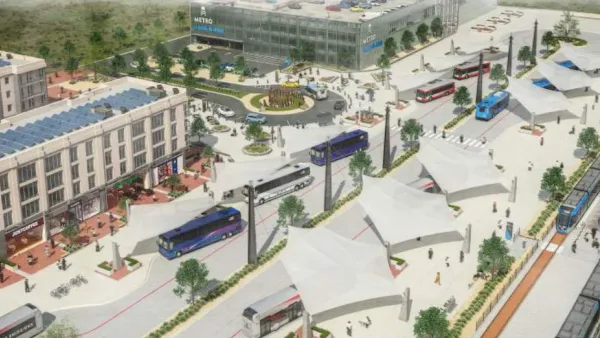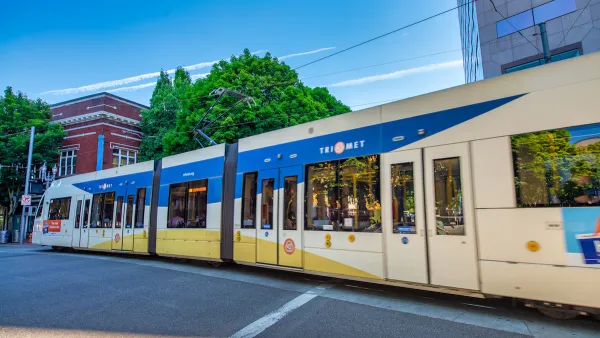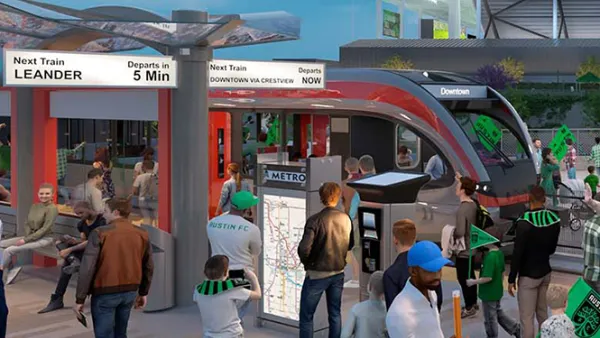The Austin City Council unanimously approved a $1 billion bond measure on August 7, subject to voter approval on Nov. 4 to provide $600 million toward a $1.4 billion, 9.5-mile light rail line and $400 million for freeway improvements.
One of the nation's fastest growing, but traffic-choked cities may once again have the opportunity to vote on a light rail line that would serve Central and Southeast Austin, writes Austin American-Statesman transportation beat reporter Ben Wear.
But the ballot language approved Thursday includes a caveat that the rail borrowing could occur only after a future City Council commits to spending an additional $400 million for road projects on highways of “regional significance,” such as Interstate 35, U.S. 183 and Texas 71.
In other words, light rail is held hostage to freeway spending, such is politics. Nevertheless, getting the council's approval was the rail line's first hurdle, reports KVUE's Ashley Goudeau. The last time light rail was put to a vote was 14 years ago, and it failed, she adds.
Appearing in the KVUE broadcast video is Austin Mayor Lee Leffingwell, a major light rail backer.
Another caveat placed on the light rail spending is that it must receive federal matching funds. If all hurdles are passed, "rail officials here have said the line would open for service about 2022 and have 18,000 boardings a day by 2030," adds Wear.
Wear also writes a comprehensive six-page comparison piece with Portland, Ore. “Almost a quarter of the city’s 300,000-plus workers ride transit, bike or walk to get to their jobs, about triple the percentage in Austin," he writes.
Portland — with 600,000 residents packed into a tightly knit area less than half Austin’s size, priority streets for bicycles and shady, wide sidewalks — has (a dense, easily walkable urban environment to produce high enough ridership to justify the huge cost shared by taxpayers throughout a metro area, referencing Jarrett Walker, a Portland-based transit consultant).
Wear end's his comparison by asking:
The question for Austin voters, in the end, is whether sprawling Austin, Texas, has what light rail requires — or ever will. And if so, can the city, coming so late to the game, afford to play?
[Hat tips to Streetsblog's Katie Pearce for Austin-Statesman piece, to AASHTO's Daily Transportation Update for KVUE's report, and to Sierra Club transportation listerv member David Orr for Ben Wear's Portland comparison piece]
FULL STORY: Austin American-Statesman: Austin City Council puts $1 billion rail, road plan on November ballot

Analysis: Cybertruck Fatality Rate Far Exceeds That of Ford Pinto
The Tesla Cybertruck was recalled seven times last year.

National Parks Layoffs Will Cause Communities to Lose Billions
Thousands of essential park workers were laid off this week, just before the busy spring break season.

Retro-silient?: America’s First “Eco-burb,” The Woodlands Turns 50
A master-planned community north of Houston offers lessons on green infrastructure and resilient design, but falls short of its founder’s lofty affordability and walkability goals.

Test News Post 1
This is a summary

Analysis: Cybertruck Fatality Rate Far Exceeds That of Ford Pinto
The Tesla Cybertruck was recalled seven times last year.

Test News Headline 46
Test for the image on the front page.
Urban Design for Planners 1: Software Tools
This six-course series explores essential urban design concepts using open source software and equips planners with the tools they need to participate fully in the urban design process.
Planning for Universal Design
Learn the tools for implementing Universal Design in planning regulations.
EMC Planning Group, Inc.
Planetizen
Planetizen
Mpact (formerly Rail~Volution)
Great Falls Development Authority, Inc.
HUDs Office of Policy Development and Research
NYU Wagner Graduate School of Public Service




























